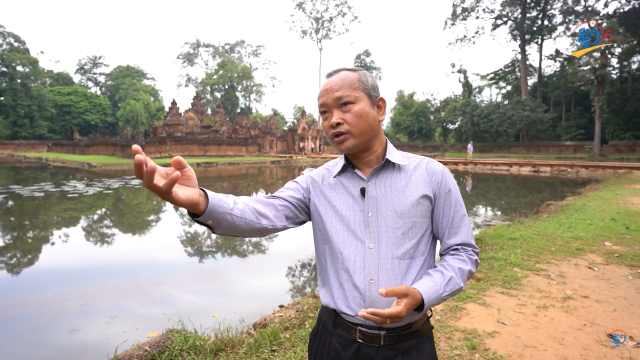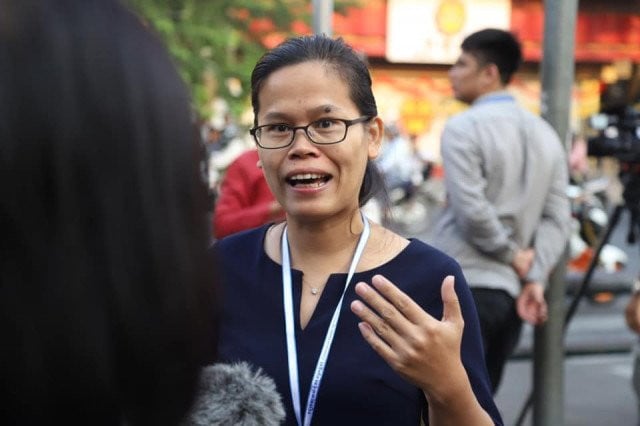Banteay Srei Temple: Its Origin and Name

- By Sem Vanna
- February 11, 2023 10:30 AM
SIEM REAP – Contrary to other regional temples such as Angkor Wat or Bayon, where large stones were laid and long moats were dug, the temple of Banteay Srei was designed through a different architectural philosophy. Although much smaller in size, this temple is exceptional thanks to its detailed stone artwork. Fractal within fractal, the more one observes closely, the more features one might see.
Khieu Chan, a specialist who has been working with the APSARA National Authority for nearly two decades, explains in detail the origin of the Banteay Srei temple to ThmeyThmey25’s reporter.
Sem Vanna: Before we dig deeper into what makes this temple special, what is the reason behind the temple’s name? What was its original one?
Khieu Chan: On the origin of the Banteay Srei temple, we do not actually know how the name came to be what it is today. It is possible that there was an original name before this, unfortunately, we cannot be sure of that. What we have in our hands is the information on the builders and the names of sacred guardians or items installed inside the temple.
_1676085582.png)
Nevertheless, the meaning of the name “Banteay Srei” is incorrectly translated by the public to be either the “women’s fortress” or the “fortress of Bay Sey” – which refers to a traditional type of offering that sounds similar to the temple’s name. [While the word “Srei” means “woman” in Khmer, “Bay Sey” is a type of religious offering made of rice, fruits, candles and traditional Khmer-style shaped objects.]
However, I will not interfere with these interpretations.
If we study the origin, the word “Banteay” itself indeed refers to fortresses according to the native villagers. But it does not specify what kind of material the fortress is made of. Either made of stones or bricks or raised above normal elevation. All are considered fortresses by the locals.
On the other hand, the word “Srei” itself can come from the word “Sri” in the Sanskrit language which is used as a prefix for the names of kings during the Angkor period to indicate blessing or power. For example, Sri Jayavarman VII. Therefore, “Sri” is a title used for high-ranking officials and especially for kings.
_1676085651.png)
Sem Vanna: Why was the temple constructed and why was this place chosen?
Khieu Chan: The temple of Banteay Srei is believed to be built somewhere during the mid-10th century, according to the discovered inscriptions. After the temple was fully constructed, it was officially and religiously inaugurated. As a matter of fact, the Banteay Srei temple is one of the few temples that was not built by kings. Instead, it was built by a great master who taught King Rajendravarman and King Jayavarman V.
Based on the inscriptions, the temple’s compound was made only for the priests, which were one of the four castes the society had at that time. The Angkorian empire and India shared a common caste system in which each cast lived their own respective lifestyle among their own groups. The compound is called Isvarapura which basically means the land of Shiva’s priests. More interestingly, this temple’s location was not picked coincidentally. If we look to the east of the temple, we can see a small hill that people commonly address as “Phnom Dei” or Mount Dei.
The name “Phnom Dei” is not a name given by people later on in time. It was a legitimate name recorded in the inscription on a temple’s door frame that was constructed on that mountain. Called Phnom Dei temple, the monument was built by King Yasovarman near the end of the 9th century when he moved his city from the region of Rolous to Angkor by using the Bakheng mountain as the center point.
Experts also commented that during the Angkorian period, it was common to use mountains as focal points especially when establishing new cities. For example, as we can see, Bakheng mountain is the center of Angkor City. Even though it was extremely challenging to build temples or capital when mountains are in between, the kings overcame the obstacles and still managed to build an empire across the tough mountains. And the same goes for Phnom Bok, Phnom Krom and Phnom Dei themselves.
_1676085741.png)
Sem Vanna: You mentioned that the temple was not built by the king. Could you please elaborate more on that?
Khieu Chan: The detailed design of the Banteay Srei temple was directed by a priest who went by the name of Yajnavaraha. More than for himself, he also dedicated this temple to his other two younger siblings. The middle tower contained a Shiva lingam which represents Yajnavaraha himself as the eldest brother. The inscription was also given the name Sri Tribhuvana Mahesvara.
As aforementioned, “Sri” is a prefix used to indicate high-ranking officials or high-status persons. Next, the word “tri” refers to three while “bhuvana” means village or world. Therefore, “tribhuvana” means three worlds. “Mahesvara”, on the other hand, refers to the might of Shiva. All in all, the name of the sacred items installed in the middle tower that goes by the “Sri Tribhuvana Mahesvara” means Shiva, the mighty god of all three worlds.
We can tell that Banteay Srei temple is beloved by many people as a large number of visitors kept flocking in to visit it. However, the main attractive part is not the architecture. Instead, it is the design and the carvings that keep on attracting people to come and see them endlessly. The carvings and images reflect the depth of art and highlight the beautiful pink stone texture of the Banteay Srei Temple.
Originally broadcasted in Khmer for ThmeyThmey25, this story was translated by Song Daphea for Cambodianess.















